[Retracted] English Education Translation System Based on 5G Network Virtualization
Abstract
In order to improve the effect of English education translation, this paper improves the 5G network virtualization algorithm and uses the typical correlation analysis method in data mining to extract the correlation relationship between the data content contained in the massive English translation user equipment. Furthermore, this paper adopts the similarity-based clustering method to realize the self-organization construction of English translation virtual community. On this basis, this paper proposes a spectrum allocation algorithm based on convex optimization, which effectively solves the problem of spectrum allocation in virtual cells. Finally, this paper constructs the functional architecture of the English education translation system based on 5G network virtualization and conducts experimental research. The experimental research results show that the English education translation system based on 5G virtualization constructed in this paper can play an important role in smart English teaching.
1. Introduction
With the introduction of the concept of “smart earth,” under the research and development of artificial intelligence, cloud computing, and other technologies, the concept of “smart” has penetrated into all fields of society. In the field of education, researchers have conducted theoretical and practical discussions and research on smart classrooms, smart campuses, and smart education [1].
The emergence of smart teaching tools provides a full range of smart teaching environments for college teaching. Among them, the intelligent assistant Yu Class, developed by the Online Education Office of Tsinghua University, has powerful functions in the teaching process before, during, and after class. In particular, the application in classroom teaching is more obvious. Its “screen projection function” can not only project the content of learning to the student’s mobile phone but also stimulate students’ enthusiasm for learning through functions such as “barrage” [2].
In the context of smart education, the optimization of English translation classroom teaching ecology can analyze students, teachers, teaching organization, and teaching environment from the perspective of ecology and build an ecological teaching model for English translation classrooms in a smart education environment. According to ecological theory, English translation teaching can be regarded as an organic, complex, and unified system [3].
In traditional translation teaching, due to the influence of a fixed teaching environment (such as classrooms), the teaching content is generally based on theory and exercises, and students lack sufficient practice and knowledge input and application. In the process of teaching, students often lack interest due to the limitations of the language in the textbooks. However, the ecological translation teaching model in the context of smart education breaks through the limitations in this respect, and the forms of teaching organization present a trend of diversification. With the help of smart teaching tools, teachers can strengthen the learning content in three links before class, during class, and after class, so that the input of knowledge presents a natural ecological inheritance, and the degree of internalization of students’ knowledge is more effective. In addition, it also balances the learning of basic English knowledge and professional knowledge. English translation teaching and learning involve the basic knowledge of English as well as the professional knowledge. If you do not handle the relationship between each other, you may lose sight of one another. The three aspects of learning before class, during class, and after class effectively avoid this problem. Teachers can choose the way of teaching according to the difficulty of knowledge. For example, the basic knowledge of English such as vocabulary, grammar, and sentence patterns is relatively easy, but it is difficult to grasp quickly. Then, in the preclass session, teachers can set tasks for students through video commentary, audio commentary, or article reading. Students can have a deeper understanding of certain knowledge points by watching or reading repeatedly. As for the more difficult parts, you can analyze in depth through classroom discussion and solve such problems in the classroom. For the problem of insufficient translation practice, students can be organized to gradually improve through activities such as translation workshops and translation companies to observe knitting internships. Teaching and learning before class, during class, and after class is an organic whole, and the three are independent of and complementary to each other.
Based on the above analysis, this article studies an English education translation system based on 5G network virtualization, which provides a theoretical reference for improving the wisdom of subsequent English education.
2. Related Work
In the edge computing network system, the network architecture that combines network function virtualization and software-defined networking transforms traditional network functions from dedicated hardware devices to virtual network function software running on standardized commercial server virtual machines [4]. On the one hand, virtual machine-based software network functions use underlying virtualization technology to bring benefits that traditional networks do not have, such as accelerating time to market, reducing hardware and operating costs, and improving security and scalability [5]; on the other hand, the use of standardized programmable interfaces that separate the data plane and the logically centralized control plane can effectively simplify maintenance operations and reduce network management costs. It is an important means to provide network flexibility [6]. Sun and Li [7] put the network function of compressing the data stream at the front and the network function of augmenting the data stream at the back, thereby reducing the bandwidth overhead of the physical link between the front and rear network functions. However, they do not take into account the computational resource overhead required by the network functions that process the data flow. Literature [8] designed a corresponding buffer for the service chain. When the buffer data packet volume exceeds the threshold, the NFVnic will appropriately limit the data flow rate to avoid the downstream virtual network function from becoming the bottleneck of the entire service chain; when it is lower than the threshold, it will appropriately increase the data rate. Literature [9] proposes to place network functions with strong processing capabilities in front of the service chain and network functions with weak processing capabilities behind the service chain to avoid performance degradation of the service chain and to sacrifice resources in exchange for performance. How to find the proportional relationship between the data flow rate and the service chain deployment resources and directly determine the resource allocation based on the data flow rate is a very difficult problem [10]. In addition, the network architecture based on software-defined networking and network function virtualization is more flexible than traditional network architectures, but this flexibility also makes the state of edge computing networks constantly change and service chain updates occur frequently. Network operators must not only ensure that the update process of the service chain is correct and consistent but also avoid loopholes in the network update process, resulting in network performance degradation or even crash [11]; faster update speed means that the time occupied by resources at the same time will be reduced, and the use of network resources will be avoided. The rate is further reduced [12]. Literature [13] chooses to wait for the current data stream to be processed before routing the new data stream to process it, but this increases the time and cost of updating. Literature [14] replicates and transfers the state of network functions in a fine-grained manner to ensure consistent properties during the update process. At the same time, in order to avoid network performance degradation, they will cache data packets in the controller during the update process. Avoid packet loss or error handling. Literature [15] arranges the update sequence between service chains under the consideration of network resource constraints, so as to complete the update of the entire network state. Literature [16] uses an OpenNF or Split/Merge update mechanism to realize the update of a single service chain. Literature [17] is too coarse-grained to study the update sequence of the service chain, and it is difficult to minimize the update time of the network state. At the same time, because their update of a single service chain relies on the OpenNF or Split/Merge update mechanism, there is no further analysis of a single service chain. The update mechanism of the service chain is optimized.
3. 5G Network Virtualization Processing
Next, this article defines the relevant concepts and elements in the English education translation system network.
Definition 1. The base station set S = {sm, m = 0, 1, 2, ⋯, Ns} under the coverage area of the macro base station is composed of one macro base station and Ns small base stations, where s0 is the macro base station and represents the small base station [18].
Definition 2. A large number of user equipment are randomly distributed in the area, U = {sm, m = 0, 1, 2, ⋯, NU} is the set of user equipment, and NU is the number of users.
Definition 3. The user equipment is running various types of applications and needs to transmit various modal data, and the vector X = {x1, x2, ⋯, xn} representing the modal data is obtained through the data analysis method.
Definition 4. Similarity sim(u, v) refers to the similarity between user equipment u and v that needs to transmit data when communicating.
Definition 5. This article introduces a “user-centered” virtual cell, breaking the concept of traditional access network centered on base stations. The cell is no longer associated with the base station. However, it is associated with the user. At the same time, it realizes the decoupling of signal transmission and base station ID and further supports network virtualization management.
Definition 6. This article assumes that the defined macro base station area is allocated logically continuous spectrum resources; that is, the available spectrum resource is C. The spectrum allocation strategy among macro base stations is beyond the scope of this article, so this article will not discuss it.
There are a large number of user equipment in the network, and a large amount of data of various modalities needs to be transmitted in real time. As shown in Figure 1, each user equipment needs to transmit multiple modal data, and there is a certain correlation between modal data blocks describing the same or similar objects.
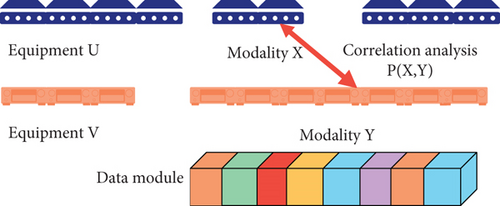
Among them, ∑xy is the covariance matrix, ∑xx and ∑yy are the variance matrices, and the goal is to find the maximum λ, that is, the canonical correlation coefficient. When the maximum λ is obtained, it corresponds to wX and wY is a typical vector.
Among them, θa,b is determined according to the application type and the importance of the data in the user equipment, and the weight between these different associated data is obtained.
Among them, (xu, yu) and (xv, yv) are the location information of user equipment u and v, respectively. In the process of clustering, this study defines the distance threshold Dmax. When the distance between two user equipment exceeds the threshold, that is, D(u, v) > Dmax, the similarity between the two user equipment is considered to be zero. The distance threshold Dmax is dynamically adjusted according to the coverage area of the macro base station, the distribution of small base stations, and the supply and demand of spectrum resources.
The elements on the main diagonal of the matrix are all 1, and sim(u, v) = sim(v, u), so the similarity matrix is a symmetric matrix. In this case, we only need to store the upper triangular part of the matrix. This effectively reduces storage space and reduces computing costs. Then, an undirected graph G = (U, E) is constructed according to the user equipment similarity matrix, where the node set describes the user equipment in the network and the edge set E = {(ui, uj) | ui, uj ∈ U} describes the similarity between the user equipment. The boundary value is defined as the similarity of two user devices. The larger the boundary value, the greater the similarity.
Among them, and NΩ are the number of user equipment clusters, L(Vi, Vi) is the number of internal connections in cluster i, is the number of connections to other clusters, Ωk is the number of user equipment in cluster i, and NΩ is the number of user equipment clusters formed.
Among them, U is the user equipment set in the network and U(Ωk) is divided into the user equipment set of cluster Ωk.
Through the abstract management of user equipment information, the clustering method based on similarity is used to divide the user equipment in the coverage area of the macro base station online to form N user-centric virtual cells, forming a virtual cell set . As shown in Figure 2, each user equipment participates in the formation of a virtual cell. Through the construction of virtual cells, the data center conducts abstract management of user equipment distributed in various locations in the network. At the same time, in the process of constructing a virtual cell, by sensing the data content transmitted by the user equipment and then predicting the data flow information of each user equipment, the spectrum resource demand of the user equipment in the network is finally determined.

Within the coverage area of a certain macro base station, various types of user equipment form a user equipment set U = {un, n = 0, 1, 2, ⋯, NU}. Through the self-organizing construction of virtual cells, the user equipment forms multiple virtual cells to form a virtual cell set . At the same time, collect and analyze various valuable user information in the network. Furthermore, the abstract and unified global information in the data center is used to perform virtualized management of spectrum resources in units of virtual cells.
Therefore, this solution allocates corresponding spectrum resources to each virtual cell through the virtualized management of user equipment information and spectrum resources.
In addition, while maximizing system capacity, focusing on user fairness, this article rewrites the optimization goal as to achieve user fairness in virtualized spectrum allocation.
For the problem of virtualized spectrum allocation based on virtual cells, the data center obtains the load information of the user equipment in the network through perception and calculation. Therefore, for the spectrum allocation model based on virtual cells, this research introduces a convex optimization method to realize virtual spectrum allocation.
Theorem 7. The virtualized spectrum allocation problem is a convex optimization problem; that is, there is an optimal spectrum allocation scheme to enable the system to obtain the maximum capacity.
Proof. For the objective function , first of all, the method of slack variables is used to make become a continuous value in the range of 0 to 1. Then, after calculation, it is proven that is a concave function. Therefore, the problem of virtualized spectrum allocation is equivalent to the following optimization problem:
At the same time, it is easy to determine that the constraints of formula (19) constitute a convex set. Furthermore, the virtualized spectrum allocation problem is proven to be a convex optimization problem with constraints on the variable . Therefore, there is a globally optimal allocation scheme for the virtualized spectrum allocation problem, which can obtain the maximum system capacity.
Theorem 8. The optimal solution of the virtualized spectrum allocation problem has a corresponding relationship with the optimal solution of the dual problem.
Proof. According to the literature, for any feasible Lagrangian multiplier , the dual function value is the lower limit of the spectrum allocation optimization function p, that is, . In addition, the spectrum allocation problem is a convex optimization problem, which usually has a strong duality. Then, the optimal value p of the original problem is equal to the optimal value a of the dual problem, that is, p′ = d′. Therefore, W has a corresponding relationship.
Solving the above problems has greater complexity. This paper uses the interior point method to solve the problem and finally obtains the maximum value of . At this time, the optimal Lagrangian multiplier value is .
4. English Education Translation System Based on 5G Network Virtualization
The English education translation system network will introduce more communication modes, such as D2D (device-to-device), M2M (machine-to-machine), and V2V (vehicle-to-vehicle). To maintain an optimal user experience in such a complex network environment, RAT selection and management must be done on the network side and the device terminal side at the same time. Heterogeneous networks are still the development direction of future communication networks. Therefore, flexible deployment and cost have become important factors for 5G networks. This requires 5G systems to be based on software implementation and virtualization technology to enable them to build different virtual core networks to meet the needs of specific applications. As shown in Figure 3, it briefly describes the diversified services, application scenarios, different network integration modes, and cloud-based layered architecture ideas of the wireless network of the English education translation system.
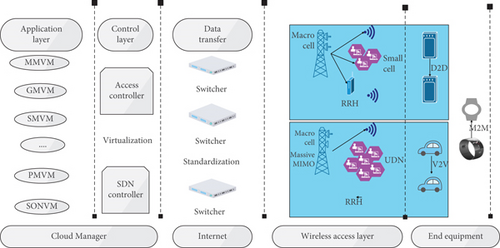
The continuous evolution of the English education translation system has put forward stricter delay requirements for the LTE system, especially the delay requirements of the control plane and the user plane. Therefore, the LTE system not only optimizes the radio frame length and transmission time interval (TTI) but also adjusts the network architecture. The current LTE system architecture is mainly composed of two parts, namely, the evolved core network EPC and the evolved access network E-UTRAN, as shown in Figure 4.
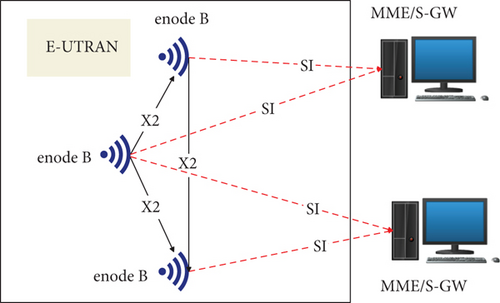
Figure 5 shows the functional division of the data processing module in the English education translation system eNB-D. As shown in the figure, some sublayers have control logic tightly coupled with data, such as HARQ in the MAC layer and ARQ in the RLC layer. Here, these control functions are still attributed to the data plane.
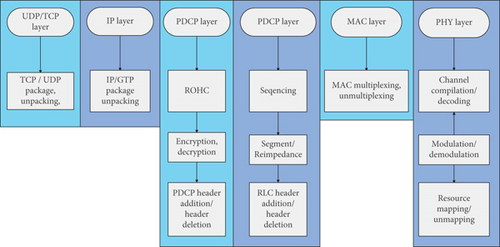
The 5G network will not only adjust the access network architecture but also improve the forwarding plane. Moreover, it uses a distributed gateway with a sinking user plane to realize distributed deployment. Through the local cloud service system, the streaming media services originally obtained from the service center through the complicated Internet network can be cached to the local cloud server. Figure 6 shows the business flow network transmission model of the English education translation system.
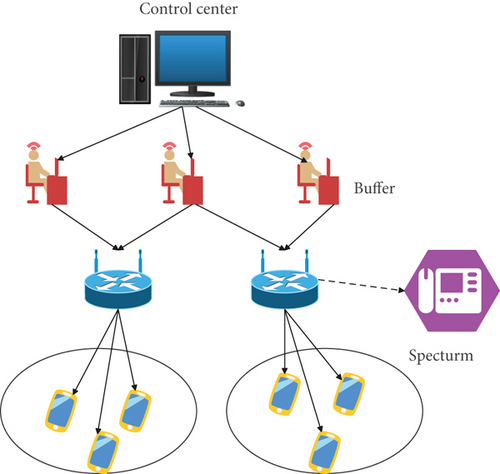
As shown in Figure 7, a service chain flow needs to update its internal network functions VNF1, VNF4, and VNF5 from the old routing path to the new routing path based on performance optimization reasons. The update time required for each network function can be obtained according to the time prediction model in the previous section. If we use OpenNF’s update mechanism to update the service chain in the figure, we first start from the data flow, and the data packets flow along the old deployment path of the service chain. It is found that the source network function “Old VNF1” needs to be updated, so it is updated.

Figure 8 is the hardware composition of this intelligent translation system, which is mainly composed of a database server, gateway server, client, and human-computer interaction terminal, including information processing module, AD module, and controller module. When translating English literary works, the user inputs the content to be translated from the client and uploads it to the database server through the gateway server for information processing. When encountering ambiguity judgments, the interpersonal interaction mode is turned on, and the human-computer interaction terminal is used for manual judgment, and the judgment results are fed back to the client and server at the same time.
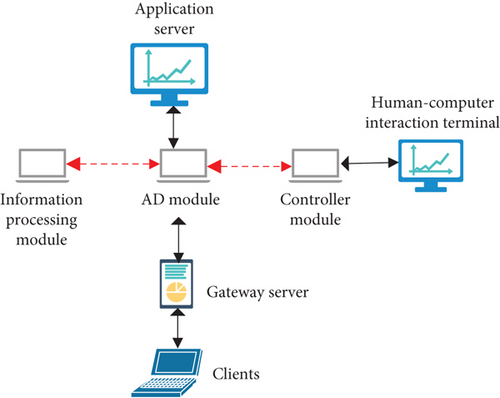
On the basis of the above research, this article studies the English education translation system based on 5G virtualization built in this article. This paper conducts experimental research by inputting multiple sets of English data and counts the experimental data, evaluates the system’s 5G data transmission and the translation effect of the English education translation system, and obtains the results shown in Tables 1 and 2.
| Number | 5G data processing | Number | 5G data processing | Number | 5G data processing |
|---|---|---|---|---|---|
| 1 | 89.09 | 17 | 89.92 | 33 | 90.06 |
| 2 | 89.91 | 18 | 88.65 | 34 | 93.82 |
| 3 | 86.08 | 19 | 92.38 | 35 | 85.87 |
| 4 | 85.88 | 20 | 91.46 | 36 | 86.60 |
| 5 | 90.67 | 21 | 89.74 | 37 | 86.76 |
| 6 | 85.86 | 22 | 92.39 | 38 | 87.28 |
| 7 | 85.78 | 23 | 86.59 | 39 | 88.43 |
| 8 | 87.34 | 24 | 85.87 | 40 | 88.68 |
| 9 | 92.17 | 25 | 91.89 | 41 | 89.94 |
| 10 | 92.01 | 26 | 88.91 | 42 | 93.01 |
| 11 | 93.30 | 27 | 86.70 | 43 | 89.39 |
| 12 | 90.24 | 28 | 85.32 | 44 | 87.12 |
| 13 | 89.91 | 29 | 91.14 | 45 | 90.43 |
| 14 | 85.27 | 30 | 88.43 | 46 | 92.14 |
| 15 | 93.01 | 31 | 89.08 | 47 | 88.79 |
| 16 | 85.60 | 32 | 89.94 | 48 | 86.09 |
| Number | Translation evaluation | Number | Translation evaluation | Number | Translation evaluation |
|---|---|---|---|---|---|
| 1 | 83.92 | 17 | 82.05 | 33 | 84.74 |
| 2 | 85.12 | 18 | 89.50 | 34 | 78.86 |
| 3 | 88.96 | 19 | 82.28 | 35 | 82.54 |
| 4 | 78.98 | 20 | 88.93 | 36 | 86.54 |
| 5 | 91.89 | 21 | 79.08 | 37 | 84.60 |
| 6 | 89.10 | 22 | 79.95 | 38 | 86.06 |
| 7 | 82.10 | 23 | 80.33 | 39 | 86.34 |
| 8 | 83.66 | 24 | 88.90 | 40 | 90.51 |
| 9 | 89.40 | 25 | 86.03 | 41 | 87.49 |
| 10 | 87.79 | 26 | 87.05 | 42 | 79.52 |
| 11 | 85.83 | 27 | 83.05 | 43 | 82.47 |
| 12 | 83.33 | 28 | 86.89 | 44 | 78.72 |
| 13 | 86.33 | 29 | 79.34 | 45 | 84.56 |
| 14 | 79.25 | 30 | 91.98 | 46 | 82.30 |
| 15 | 82.01 | 31 | 83.60 | 47 | 89.96 |
| 16 | 82.52 | 32 | 80.33 | 48 | 87.69 |
From the above research, it can be seen that the English education translation system based on 5G virtualization constructed in this paper can play an important role in smart English teaching.
5. Conclusion
With the advent of the 5G era and the continuous development of computer technology, many technologies are affecting and improving the quality of people’s lives. At the same time, it also affects the teaching mode of college classrooms. In particular, the gradual popularization and improvement of virtual reality technology under 5G networks have enabled immersive classroom teaching to be realized. The traditional classroom teaching centered on the knowledge imparted by teachers will gradually be replaced by immersive classroom teaching based on virtual reality technology with the popularization of 5G networks. The application of virtual reality technology is very extensive. In the future, classroom teaching has a broader platform and a more open environment. How to combine the advantages of 5G in the construction of classroom teaching in colleges and universities to better serve education has become a very important and urgent research topic. Based on the above analysis, this article studies an English education translation system based on 5G network virtualization and provides theoretical references for improving the effect of smart teaching in subsequent English education. The experimental research results show that the English education translation system based on 5G virtualization constructed in this paper can play an important role in smart English teaching.
Conflicts of Interest
The author declares no competing interests.
Acknowledgments
This study is sponsored by Research on the Professional Development of English Teachers Based on the Status Quo of College English Teaching in Higher Vocational Colleges (No. 18JK0057).
Open Research
Data Availability
The labeled dataset used to support the findings of this study are available from the corresponding author upon request.




